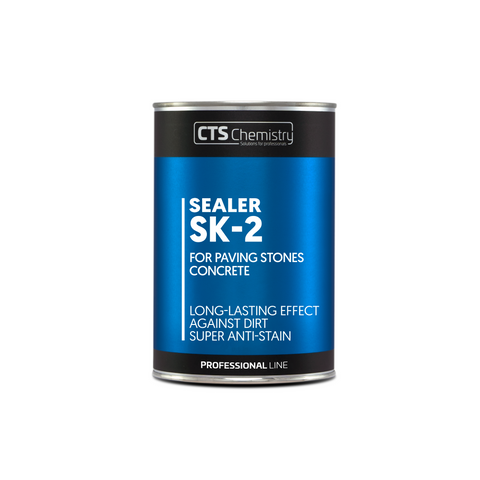

CTS Chemistry
<tc>SK-2 Solvent-based sealer for paving stones and concrete (wet stone effect)</tc>
Size
which does not make it slippery.
Application area:
SK-2 impregnation is a specialised substance for paving stones and
concrete, based on a resin in a dearomatized organic solvent. Its particles
deeply penetrate the mineral surface, creating an invisible, but effective
and durable protective barrier with the surface of the paving stone.
The substance dedicated to the impregnation of paving stones and other
concrete surfaces.
A professional substance that gives the paving stones a distinctive, vivid
colour and protects them against dirt. It strengthens the colour of
cobblestones, eliminating the effect of faded cobblestones.
The impregnation creates a protective layer on the surface that
permanently protects both new and old concrete products against the
negative influence of weather conditions.
It prevents water and dust from penetrating the substrate.
It protects against stains.
The surface of the paving stones becomes easy to clean.
The created layer prevents the formation of fungi, lichens and mold.
Application instructions:
SK-2 impregnation is produced in a ready-to-use form. Do not dilute.
The substrate should be dry, compact, not frozen, and thoroughly cleaned of dust, dirt, oils, fats and waxes. Remove
unstable parts of the surface that could affect uneven distribution of the impregnation.
Before using the product, mix it vigorously.
Before starting work, tests should be carried out in a small area to check the effect of the impregnation on the
substrate.
Spread the impregnation evenly with a roller or a brush and leave it for a few minutes so that the required amount of
the substance is absorbed into the substrate. It is recommended to apply the second layer in a short time using the
"wet on wet" method.
Leave it to dry for about 3 hours.
During this time, the impregnated surfaces should be protected against rainfall and a mechanical damage.
Only pedestrian traffic is allowed, not earlier than 24 hours after the completion of impregnation.
The time of full hardening of the impregnation is up to 72 hours. at an ambient temperature of + 20 ° C and a relative
humidity of 65%.
Paving stones and other concrete surfaces can be impregnated after complete curing, i.e. at least 28 days from their
production.
Efficiency
Depending on the absorbency of paving stones or concrete, 1 litre of the preparation can be impregnated
from 5 to 10 m2 - with a single impregnation.
Comments and recommendations
Do not impregnate surfaces with visible salinity (blooms), as it may intensify the process of crystallization of building salts
and destroy the base material.
Application method
A brush or a roller
Drying time: depending on temperature and humidity - 2-3 hours.
Application temperature: from +5 to + 30 ° C
Colour and form: colourless liquid
Density: approx. 0.9 g / cm3
Flash point: approx. 51oC
Fragrance: characteristic of de-aromatized solvents
Water absorption coefficient: Wd <0.1 kg / m2 x h1 / 2 or <7.5% acc. PN-EN 1504-2 / EN 13580 /
Water vapor diffusion resistance: Sd = 0.0 [m]
Alkali resistance - measured with water absorption according to PN-EN 1504-2 / EN 13580 <10%
Penetration depth:> 2 mm, measured according to EN 14630.
Drying rate coefficient class 2 to 1 / depending on the degree of absorbency and water absorption of the substrate /,
measured according to EN 13579.
Expiry date:
Use the substance within 36 months from the production date shown on the packaging.
Packaging:1 litre and 5 litre cans
Caution:
A solvent product. The general safety rules should be applied in accordance with the safety data sheet. Store in the original
packaging at a temperature between +5 and + 30 ° C. Protect against overheating, max. + 30 ° C. Smoking and drinking
alcohol are strictly forbidden during impregnation works. It is forbidden to perform impregnation works in strong sunlight
and high temperatures. Keep away from children. Ventilate closed rooms well. Use chemical resistant protective gloves
and protective clothing. Avoid contact with skin and eyes. Avoid breathing product vapors. Be careful when working with
flammable solvents.


